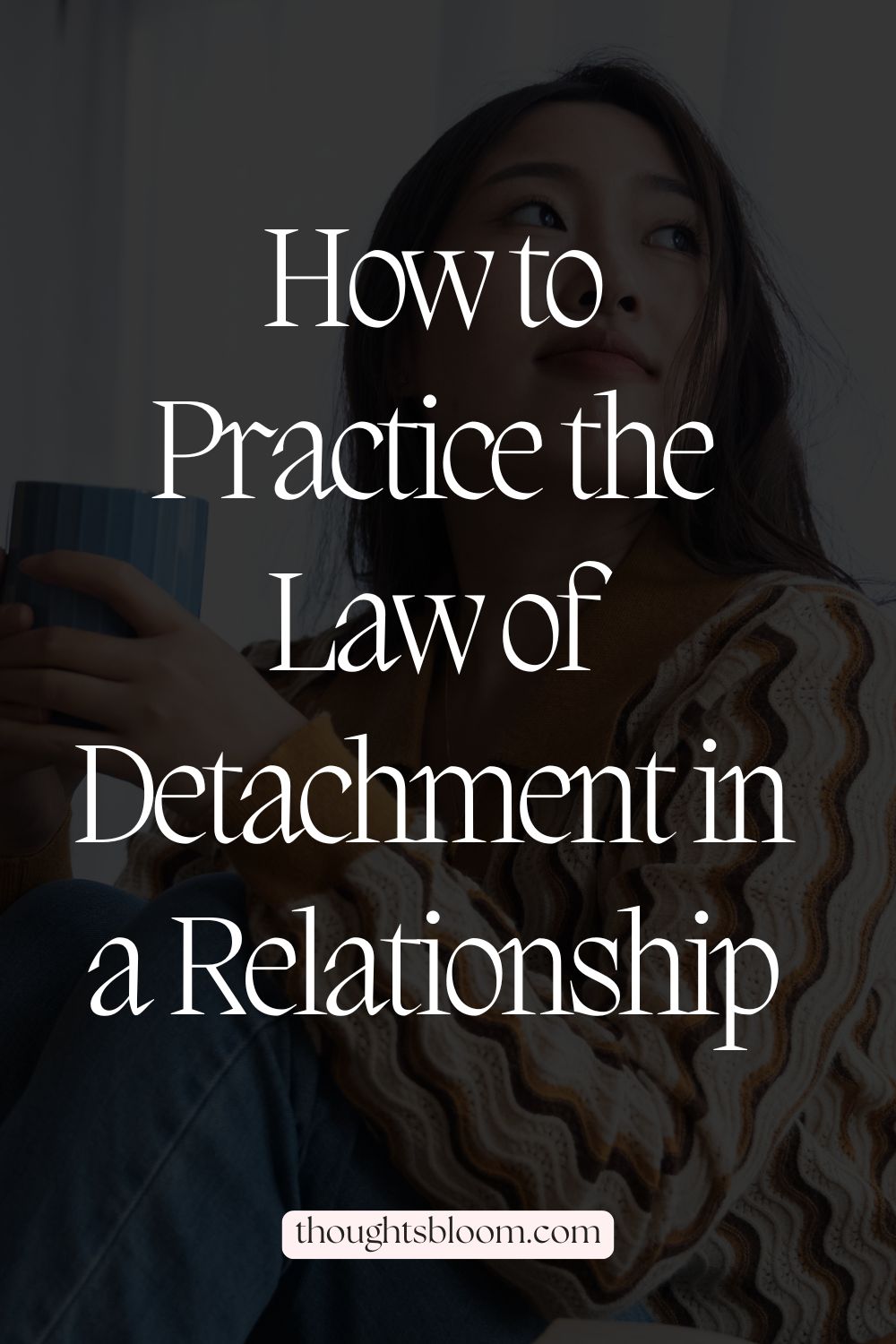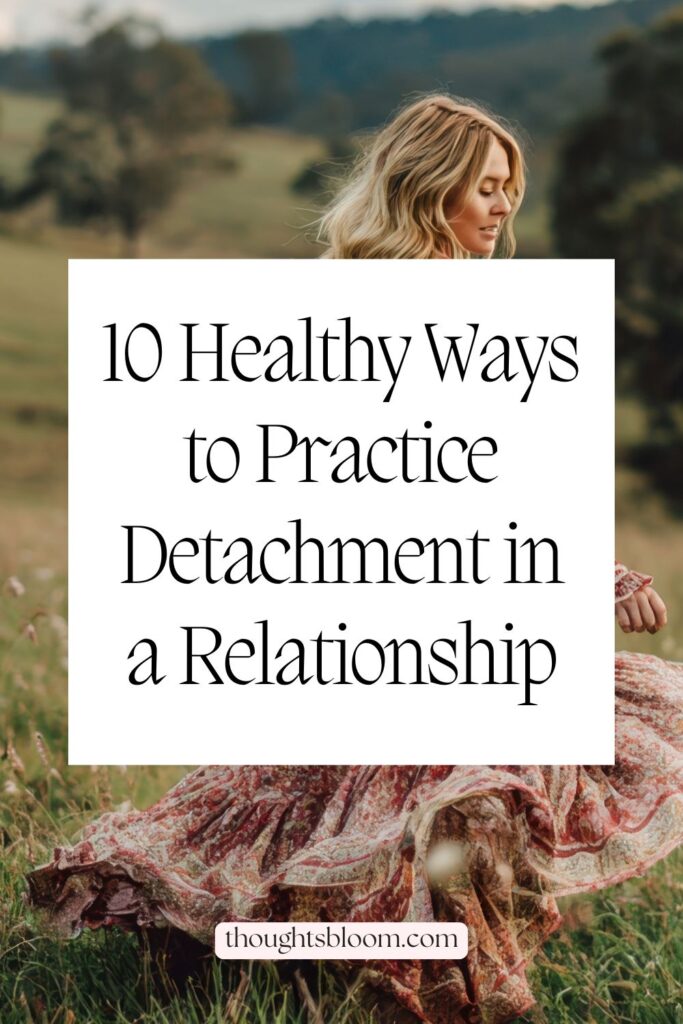How to Practice the Law of Detachment in a Relationship
The secret to lasting connection? Learning how to care without clinging.
When most people hear “detachment” in the context of love, they think cold, uncaring, or emotionally distant.
But the law of detachment isn’t about pulling away. It’s about letting go of the illusion that you can control love, people, or outcomes.
True detachment allows love to breathe. It helps you stop grasping, overanalyzing, and trying to manage everything in your relationship. When practiced wisely, detachment deepens connection, because it replaces fear and pressure with trust and peace.
Learn what the law of detachment really means, how it applies to relationships, and how to practice it without losing the warmth and closeness you value.
What Is the Law of Detachment?
The Law of Detachment comes from spiritual and psychological teachings—especially those popularized by Deepak Chopra and mindfulness traditions.
At its core, it says: “In order to attract what you desire, you must release your attachment to how it will come or when it will come.”
Applied to relationships, it means:
- You can love deeply, but you don’t cling.
- You can care, but you don’t try to control.
- You can hope for connection, but you don’t panic when things don’t go your way.
Detachment isn’t indifference. It’s inner security. It’s knowing that even if someone disappoints you, withdraws, or changes, you’ll still be whole.
Why Detachment Matters in Love
When you love someone, it’s easy to get attached—to their attention, affection, and the role they play in your life. That attachment can quietly morph into dependency:
- You start needing constant reassurance.
- You worry about losing them.
- You measure your worth by how they treat you.
That kind of emotional attachment drains both people. It creates anxiety and resentment instead of ease.
Detachment, however, allows love to evolve naturally. When you’re not clinging or fearing loss, your energy becomes lighter. You show up as your full self—confident, grounded, and present.
The paradox is this:
When you let go, love has the best chance to stay.
The Difference Between Love and Attachment
Let’s make this distinction clear, because it’s the heart of the law of detachment.
| LOVE | ATTACHMENT |
| It comes from abundance | It comes from fear |
| It allows freedom | It demands control |
| It seeks understanding | It seeks validation |
| It feels peaceful | It feels anxious |
| It grows through trust | It shrinks through insecurity |
Love says, “I want you to be happy, even if it’s not always with me.” Attachment says, “I need you to be mine, or I can’t be okay.”
Detachment invites you to love without clinging. To appreciate the connection while knowing that both of you are free to choose it, every day.
Signs You’re Too Attached in a Relationship
Before you can practice detachment, it helps to get honest about where attachment may be running the show. These are six signs you’re too attached to your partner.
You overthink every message or interaction
When you’re deeply attached, every small detail feels loaded.
You reread texts, analyze emojis, and worry about what their tone means. If they take a little longer to respond, your mind jumps straight to “Did I do something wrong?” or “Are they losing interest?”
What’s really happening underneath is anxiety. The need for constant reassurance that you’re safe in the relationship. People have lives, moods, and moments that have nothing to do with you.
Your mood depends on their behavior
If your partner’s good morning text makes your day—and their silence ruins it—you might be emotionally dependent on their validation.
You feel high when they’re affectionate and low when they’re distracted. It’s like your emotional thermostat is controlled by someone else’s settings.
This kind of attachment can leave you drained, because you’re constantly adjusting to match their energy. Healthy connection means your sense of peace stays steady even when theirs fluctuates.
You fear being alone
It’s normal to want companionship. But when solitude feels unbearable, it may signal deeper attachment anxiety.
You might fill every gap in your schedule with your partner, or feel restless when they’re busy. The thought of spending a weekend alone makes you uneasy. This fear often stems from a belief that your wholeness depends on another person’s presence.
The truth: being alone is not the same as being abandoned. Solitude is where self-trust grows.
You try to “fix” or control outcomes
You might find yourself trying to steer the relationship—nudging them to text more, to open up, to love you in a particular way.
Maybe you overexplain your needs, hoping they’ll “get it” and behave differently. Or you replay conversations, wishing you’d said the “right” thing to get the reaction you wanted. Control usually hides fear: fear of rejection, uncertainty, or loss.
The problem is that the tighter you grip, the more love slips through your fingers.
You lose your sense of self.
When you’re overly attached, your world starts to orbit around your partner.
You might neglect friendships, skip hobbies, forget boundaries, or let your goals fade because you’re focused on the relationship. Your identity becomes blurred. You stop asking what you want or need outside of the partnership. It’s not love that dissolves you, it’s fear of losing love.
The irony is that the more you disappear into someone else, the more disconnected the relationship can become.
You confuse passion with anxiety
Some relationships feel intoxicating. Your heart races, you can’t stop thinking about them, every touch feels electric.
It’s easy to call that chemistry, but sometimes it’s anxiety dressed up as intensity. If you feel constantly on edge—waiting for texts, fearing rejection, craving reassurance—you may be mistaking emotional chaos for romantic depth.
Passion rooted in peace feels steady and alive. Passion rooted in attachment feels thrilling but unstable. The test is simple: after time together, do you feel calm and connected—or nervous and unsettled?
How to Practice the Law of Detachment in a Relationship
Let’s move into the practical side. Detachment isn’t something you achieve once. It’s a lifelong mindset you nurture.
Here’s how to live it, step by step:
1. Reclaim Your Inner Center
The foundation of detachment is emotional independence. That means building your sense of peace, joy, and identity from within, not from your partner’s validation.
Try this:
- Spend time alone regularly, not as punishment but as nourishment.
- Cultivate interests and friendships outside your relationship.
- Keep a personal journaling or meditation habit to reconnect with yourself.
Making space for your individuality again keeps you centered. And when you’re centered, you can love without losing yourself. A healthy relationship has two whole people, not one merged identity.
2. Let Go of the “Outcome Addiction”
Attachment thrives on “what ifs”:
- What if they stop loving me?
- What if this doesn’t work out?
- What if I never find someone else?
These thoughts fuel anxiety because they’re rooted in control. Detachment, on the other hand, invites you to accept uncertainty as part of love.
Remind yourself every time that, “I can want closeness and still be okay without guarantees.”
Practice releasing the need to predict or secure the future. Focus on showing up fully in the present moment instead.
3. Observe, Don’t Obsess
Mindfulness helps you detach from emotional storms. When you notice jealousy, fear, or insecurity, pause before reacting.
Ask yourself:
- What am I feeling right now?
- What story am I telling myself about this feeling?
- Is it true—or just a reaction to fear?
You can acknowledge your emotions without letting them dictate your behavior. Observation creates space between feeling and action, which is where wisdom lives.
4. Practice Radical Acceptance
This one’s tough but freeing.
Accept your partner as they are, not as you wish they’d be.
You can request change, but you can’t force it. Detachment honors reality over fantasy. It means letting your partner’s choices teach you who they are—and deciding whether you can love them as such.
When you stop trying to mold them, you create space for genuine intimacy.
5. Release Control and Trust the Flow
Control comes from fear while trust comes from faith. Practicing detachment means loosening your grip on how things should unfold.
This doesn’t mean giving up on the relationship. It means allowing it to grow naturally.
Trust that what’s meant to stay will stay, and what’s meant to leave will make room for something better.
Try this mindset shift: “I don’t chase, I align. What’s mine will meet me halfway.”
6. Maintain Healthy Boundaries
Detachment means not letting anyone walk over you. It strengthens your boundaries because you’re no longer driven by fear of loss.
Boundaries protect your energy and allow mutual respect to flourish.
You can say:
- “I need space right now.”
- “That behavior doesn’t work for me.”
- “I love you, but I also love my peace.”
7. Let Love Evolve Naturally
Relationships are dynamic. The more you cling to a fixed idea of what love “should” look like, the more you resist growth.
Detachment asks you to be open—to let your connection change, deepen, or even end if that’s where truth leads. It’s faith in love’s ability to renew itself when given space.
8. Focus on Your Side of the Street
You can’t control how your partner behaves, but you can control how you show up.
Detach from the urge to “fix” them or force harmony. Instead, focus on your own growth, communication, and emotional maturity. When you stay accountable for your energy, your relationship becomes a reflection of that inner stability.
9. Use Gratitude as an Anchor
Attachment thrives on scarcity—the subtle belief that love could vanish at any moment. Gratitude interrupts that loop.
When you’re grateful, you shift focus from what’s uncertain to what’s present. Instead of thinking, “They haven’t texted all day,” you catch the thought and pivot toward, “I’m thankful for the honesty we share,” or, “I appreciate that I get to experience love at all.”
Try small daily practices:
- Every morning, name one thing you appreciate about your partner—not necessarily grand gestures, but small consistencies (the way they listen, how they make coffee, the comfort of shared silence).
- When anxiety hits, breathe in slowly and identify one thing you’re glad for right now in your relationship.
Over time, it builds emotional security. When you live from that calm center, you stop grasping for control and start trusting connection as it unfolds.Gratitude keeps your mind from spiraling into lack and re-centers you in abundance.
10. Let Time Do Its Work
Detachment often tests your patience. We’re wired to want immediate clarity—a label, an answer, a sign. But love and healing move on their own timelines.
Sometimes space or silence is what allows understanding to surface. Sometimes people need distance to remember what matters.
Over time, you’ll notice you:
- Respond, instead of react.
- Feel secure, even in silence.
- Love more purely, without bargaining for affection.
Healing attachment finally means you stop refreshing your phone, replaying every conversation, or forcing progress before both people are ready.
Download the Free Couple Journal Notebook
This free printable journal is filled with 100 guided prompts and space to reflect, reconnect, and document your love story—one question, one page, one honest moment at a time.
Common Myths About Detachment
Let’s clear up a few misconceptions:
“Detachment means I shouldn’t care.”
It’s the opposite. You still care deeply, you just stop confusing caring with controlling. Detachment turns love into a gift rather than a transaction. You offer care freely, without needing constant return to feel secure.
“If I detach, I’ll lose the relationship.”
If you loosen your grip, you think the bond won’t fade. However, clinging doesn’t protect love. It suffocates it.Healthy detachment doesn’t drive people away. It actually creates safety — because both partners feel trusted and free.
“Detached people are emotionless.”
Detachment isn’t emotional numbness. It’s emotional maturity. You still feel love, joy, frustration, and desire. The difference is you don’t let those feelings run your life or dictate your worth. Detachment allows you to experience emotion fully without being consumed by it.
“It’s selfish to detach.”
On the surface, it might look like you’re pulling back or caring less. But detachment isn’t selfish, it’s being self-responsible. You’re saying, “I’ll manage my own emotions instead of making you responsible for them.” That’s emotional accountability.
Exercises to Strengthen Detachment
Detachment is felt through small, consistent shifts in how you show up. These practices help retrain your mind and body to find calm within uncertainty and connection without control.
- Morning check-in: Ask, “What do I need from myself today, not from others?”
- Breath awareness: When anxiety rises, breathe in calm, exhale control.
- Write and release: Journal about your fears, then literally write “I release this” at the end.
- Silent pauses: When you’re tempted to react, count to ten. Observe what’s underneath the urge.
- Affirmations: Repeat affirmations that root you in calm presence.
- “I allow love to flow freely.”
- “I am complete within myself.”
- “I trust life’s timing.”
Wrap-Up: The Law of Detachment in a Relationship
Practicing the law of detachment in a relationship is a quiet revolution. It teaches you to love without losing yourself—to hold someone’s hand without holding them hostage.
Detachment refines it. It shifts your energy from need to choice, from fear to freedom. When you let go of control, you make space for something more enduring than possession: a love rooted in trust, respect, and flow.
So breathe. Let it unfold. What’s meant for you will never need to be chased.










